Listen to this article:
Key Takeaway
Discover the meanings behind the 12 most common Sanskrit symbols used in yoga and spirituality.
Anyone who has attended a yoga class or tried out meditation has probably encountered words and symbols in Sanskrit. In fact, almost all yoga poses are named for their Sanskrit titles and most mantras are recited in Sanskrit as well.
This holy ancient language sounds as beautiful as it looks. You can often find it in paintings, on prayer flags, on yoga mats, and inked as tattoos. Sanskrit symbols are important reminders and metaphors for various spiritual and moral ideas often used in Buddhism, Hinduism, and yoga philosophy.
But what do all these Sanskrit symbols mean? Is it disrespectful to wear them on your clothes or get them tattooed? Here’s everything you need to know about the 12 most common Sanskrit symbols and their meanings.
Prefer video? Here’s the one we created to better explain these 12 Sanskrit symbols:
Contents
What is Sanskrit?
Sanskrit is the sacred ancient language of India and southern Asia. The historical religious texts of Buddhism, Hinduism, and Jainism are written in Sanskrit. While Sanskrit is only spoken by about 1% of Indians, it remains alive in holy uses and religious ceremonies. It is also the root of Tibetan script (uchen script), which is the handwritten cursive used throughout Tibet and the Himalayas.
The Hindu Sanskrit seed syllable “om” is the most widely recognized Sanskrit symbol used as a base of spiritual mantras and chants. The beautiful calligraphy and soothing sounds of this language are used throughout modern spiritual, meditation, and yoga practices.
Most asanas (yoga poses) are named for their traditional Sanskrit words, such as Ustrasana (camel pose), Utkatasana (chair pose), and Bhujangasana (cobra pose).
12 Common Sanskrit Symbols in Yoga
There are hundreds of Sanskrit words and symbols found throughout Eastern spirituality. These are the 12 most commonly recognized in the West as part of yoga and meditation practices.
1. Aum or Om Symbol

The most widely recognized yoga symbol in the world is the Om symbol (ॐ). It is a nearly universal representation of meditation and yoga philosophy. This 3-shaped Sanskrit script embodies many important concepts in both Hindu and Yogic traditions.
In Hinduism, Om is the Hindu Sanskrit seed mantra that is used in every other mantra. It is considered the first syllable to be uttered at the dawn of the cosmic universe. Similarly, Buddhists believe that Om was the sound from which the gods were created. It represents the ultimate reality and truth of existence.
As a spiritual icon, the calligraphy of the Om symbol also has important meanings. The three curves represent the three states of consciousness (the waking state, the dream state, and the unconscious state), with the upper semicircle symbolizing maya (or illusion) that blocks spiritual development.
The Om symbol can be found on everything from yoga clothing to wall murals to tattoos to jewelry. As long as it is used respectfully, it is generally considered OK to display the Om symbol as a spiritual yoga sign.
Read this article to learn more about the sacred meaning of Om and its uses in yoga.
2. Ahimsa
The Sanskrit word Ahimsa translates to “non-harming”, “nonviolence”, or “noninjury”. It is one of the 5 yamas of yoga, which are part of the moral codes outlined in Patanjali’s Yoga Sutras. Traditional Buddhism holds Ahimsa as a core principle of universal love, kindness, and compassion. Leaders like Gandhi, the Dalai Lama, and Mother Teresa embody the doctrine of ahimsa.
In Sanskrit script, ahimsa is a beautiful word often integrated into tattoos:
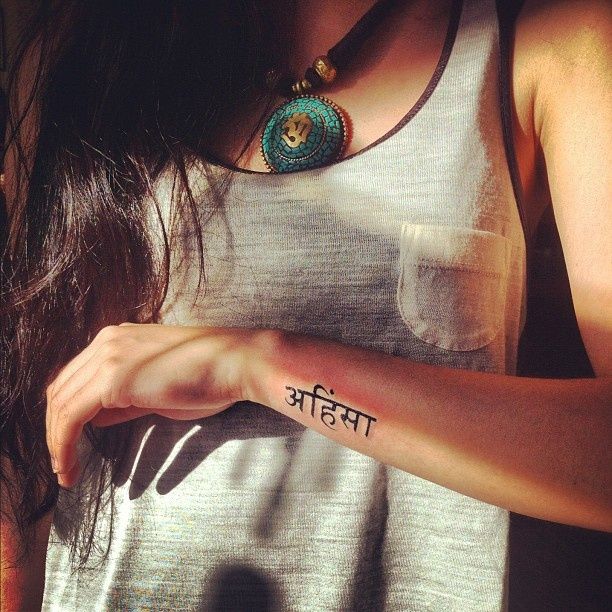
Ahimsa is also often linked to vegan and vegetarian diets because of its association with not harming living beings. It can also be applied to any area of your life wherein you would like to cultivate more peace by avoiding harmful language, actions, or negative thoughts.
3. Mandala
The dazzling geometry of mandala symbols can be found all over yoga mats, yoga studios, murals, clothes, and coloring books. The enticing geometry of these circular drawings is designed to calm the mind and symbolize harmony. Some people even use mandala adult coloring books as a form of stress-relief and meditation.
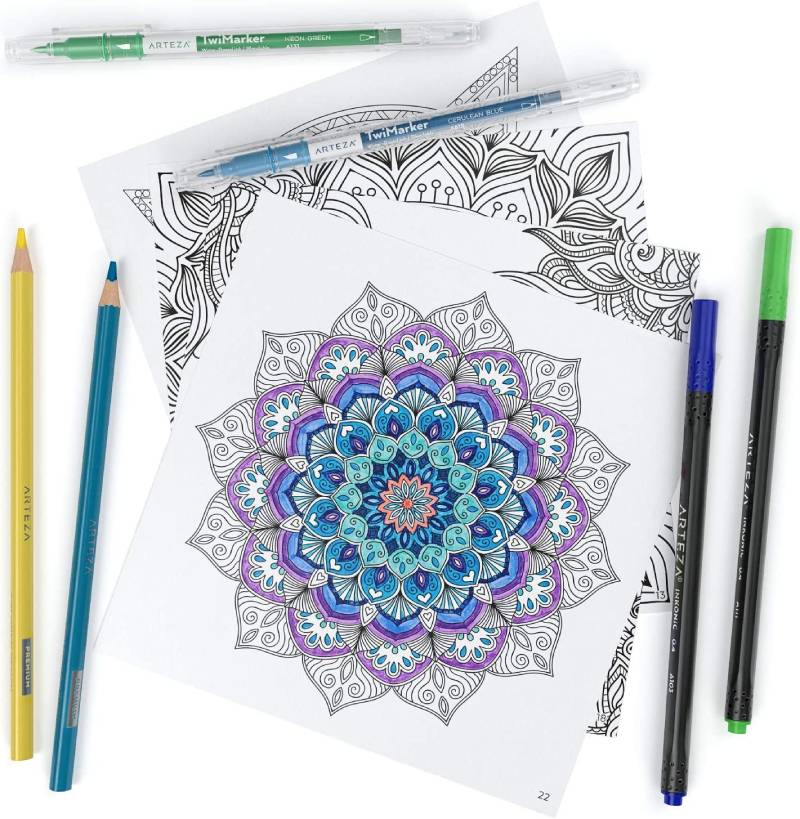
The Sanskrit word mandala literally means “circle” and represents the cyclical nature of the universe. In yoga and meditation, mandalas symbolize impermanence. You may have seen the inspiring videos of monks drawing elaborate sand mandalas and then wiping them away:
4. Hamsa
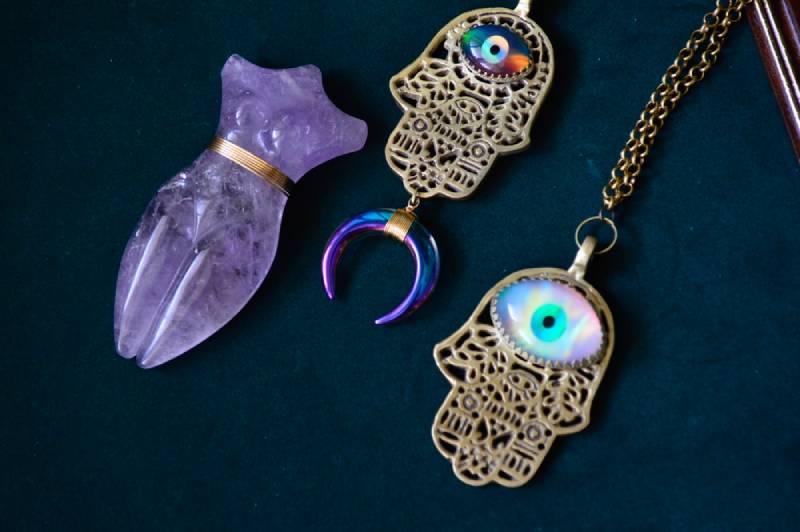
Hamsa has roots in North African and Middle Eastern philosophy, but its spiritual significance can be found in Buddhism, Hinduism, Judaism, and Islam traditions. The hand symbolizes good luck and positive fortune. As a yoga symbol, it is often found on jewelry and clothing along with the evil eye symbol to repel negative energy.
We love this hamsa and evil eye necklace to help keep positive vibes on and off the mat.
5. Seven Chakras Symbols
Eastern philosophy recognizes seven energy centers in the body called chakras. In the Sanskrit language, chakra literally means “wheel”. These centers were first mentioned in ancient Indian texts called the Vedas over 3,000 years ago.
Each chakra symbol is correlated with certain body parts, spiritual beliefs, crystals, mantras, and emotions. You can use certain yoga poses to help un-block stagnant energy in a particular area of your body or your life.
- Root Chakra (Muladhara): Symbolized by the color red, located at the base of your spine, associated with safety and groundedness
- Sacral Chakra (Swadhisthana Chakra): Color orange, linked to emotional and self-identity as well as creativity, located near the pelvis
- Solar Plexus Chakra (Manipura): Color yellow, located near the belly button, associated with confidence and self-esteem
- Heart Chakra (Anahata): Represented by the color green, located in the heart center, associated with love and inner peace
- Throat Chakra (Vishuddha): Linked with the color blue, located in the throat, associated with self-expression and communication
- Third Eye Chakra (Ajna): Color purple or dark blue, linked to imagination and spiritual wisdom, located on the forehead between the eyebrows
- Crown Chakra (Sahasrara): The highest chakra, linked to the color white or violet, associated with spiritual awakening, unity, and oneness
All of the chakras can be used as yoga symbols and are associated with specific syllables during chanting as well. The Heart Chakra and Third Eye Chakra tend to be the most popular for tattoos and yoga clothing.
6. Unalome
The unalome symbol has a curled base spiral, looping curves upward, and a crown of 3 dots. This elegant swirling Buddhist symbol has gained popularity in the west as a tattoo and yoga symbol, but many people don’t know what it truly means.
This ancient emblem actually embodies an entire philosophy of human existence: it essentially says that we are all on our own path, but it is all part of the same path. The twists and turns of life’s unexpected events are all meant to give us a better understanding of the meaning of human life.
7. Lotus Flower
Also known as a water lily, the lotus flower symbolizes rising above adversity. In its native habitat, this flower rises grows from muddy, murky waters and blossoms into a gorgeous pink or purple flower, yet the lotus petals never touch the dirty water below.
In Hindu culture, the lotus flower represents spirituality, fertility, prosperity, and inspiration for overcoming hardships.
In Egyptian culture, the lotus flower symbolizes rebirth or reincarnation after death. In The Egyptian Book of the Dead, certain rituals and spells are thought to help you reincarnate into a lotus after you die.
The lotus is significant in many other religions as cultures as well, but it ultimately represents a spiritual journey from dark into light.
8. Yin Yang
This classic black and white circular symbol is representative of the interconnectedness of the world. Though commonly associated with Taoism, Zen, and Chinese philosophy, the yin yang is also a significant Sanskrit symbol that has meanings in both Hinduism and Buddhism as well.
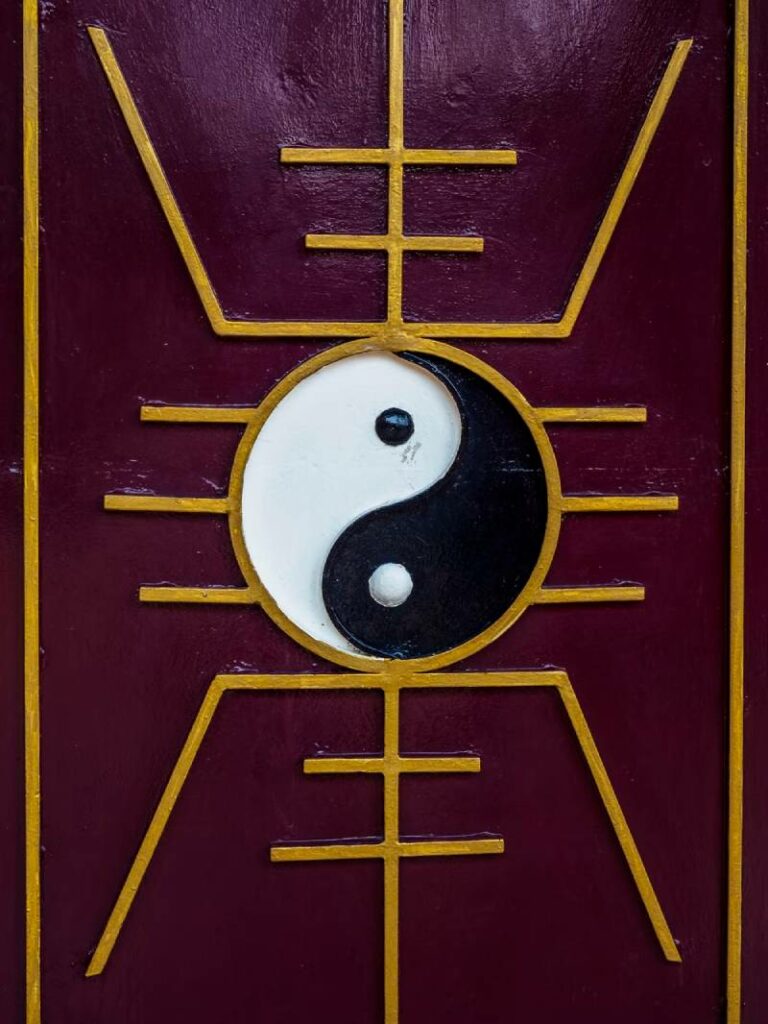
It’s likely that the yin and yang concepts originated in India over 6,000 years ago. The terms were likely derived from the Sanskrit words yoni and linga, which represent the female and male principles. Together, they represent the interconnectedness of the entire world and the duality of existence.
- Yin/Yoni: Female, dark, passive, negative, Nature, Shakti (universal energy), universal womb, Mother Goddess, Parvati,
The white dot on the black background indicates that the opposite cannot exist without the other. It is a reminder of balancing the male within the female energy.
- Yang/Linga: Male, light, active, positive, Purusha, Shiva, the beginning of creation, all of consciousness,
Similar to the yin side, the black dot on white background shows that feminine still exists in the masculine and shows that there is no absolute of either.
In yoga, you can find the yin yang symbol as a reminder of balance. After all, the term yoga comes from the Sanskrit root yuj, which means “to unite. The yin yang ultimately symbolizes harmony and the unifying of opposites.
Nothing is all “good” or all “bad”. The light cannot exist without the darkness.
9. Buddha Image
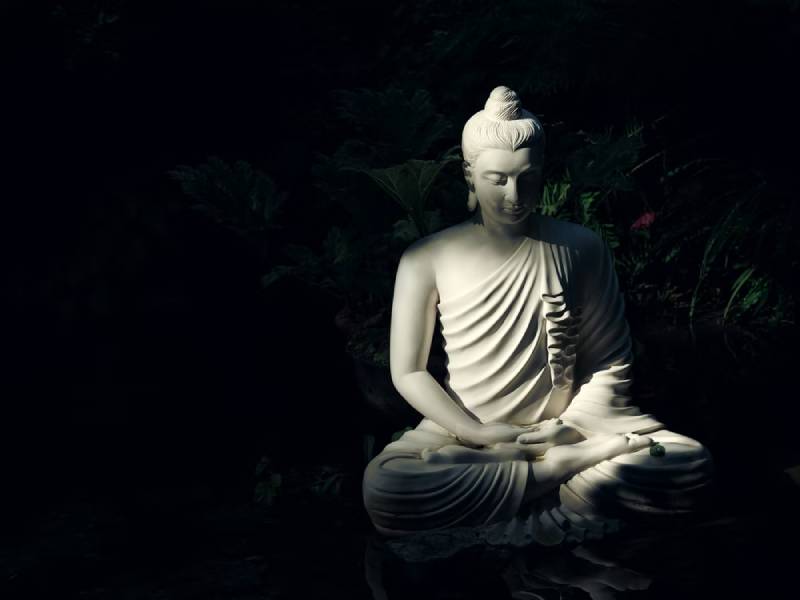
The Buddha is a universal figure of enlightenment and spirituality. Ancient Buddhist stories tell of Siddhartha Gautama, who lived in the 6th century BC and was said to meditate beneath a Bodhi tree to alleviate suffering in the world.
Though he was raised in an affluent family, Gautama felt very strongly that the world around him was hurting. He relinquished his lavish lifestyle to live in poverty but found this unsuitable for understanding or helping others. He decided to take the “middle way”, which was his approach to living between the two extremes: continuing on his spiritual journey with overindulgence but also without deprivation.
He spent 6 years searching for spiritual freedom and meaning in his life before he ultimately achieved enlightenment under the Bodhi tree. His teachings of compassion, oneness, non-violence, meditation, and improvement created the foundation for Buddhism.
In Sanskrit, Buddha is written like this:
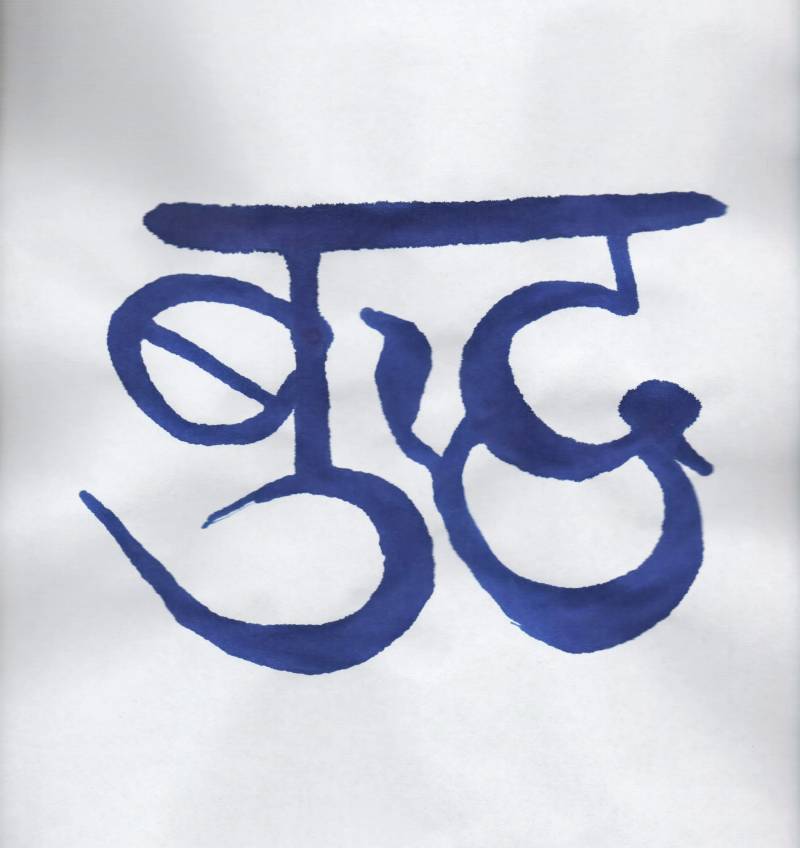
The symbol of his head and body in meditation can be found in sculptures, paintings, clothing, and beyond. Some find it disrespectful to display the Buddha if you are not a devout follower of Buddhism. Others agree that it is perfectly fine to utilize this as a spiritual yoga sign as long as the image of the Buddha is displayed respectfully.
10. Ganesh
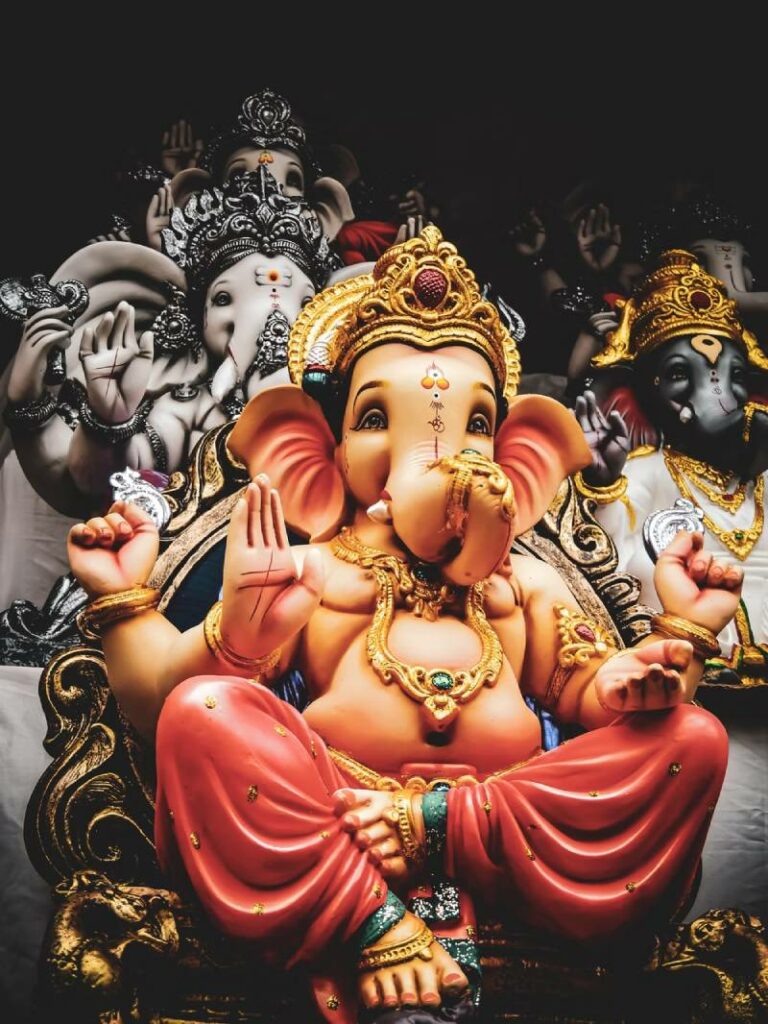
In the Hindu religion, Lord Ganesh is depicted with a large elephant head. He is a Hindu symbol of wisdom, intellect, and understanding of life.
The word Ganesh comes from the Sanskrit words gana, which means “group” or “multitude” and isha, which means “lord” or “master”.
Traditionally, Ganesh is worshiped before beginning a new project or task. He is said to clear the path of obstacles and help you move forward in life.
11. Mala Beads
A mala is a loop of 108 prayer beads that are used for counting the number of repetitions of a mantra or prayer during meditation. They are used in Buddhism, Hinduism, Jainism, and Sikhism.

Mala beads are an important meditation tool often used in yoga as well. The Sanskrit symbols for mala (माला) directly translate to “garland”. Mala beads are often worn as a necklace or displayed on altars for use during rituals.
12. The Number 108
You will notice that the number 108 can be found throughout Eastern philosophy as well as in yoga spiritual symbols. 108 is a sacred number with a variety of meanings. In Hinduism, it is the holiest number. It represents:
- The whole of our existence
- Spiritual completion
- 108 sacred sites in India
- 108 different types of feelings (36 past, 36 present, and 36 in the future)
- 108 sacred pressure points of the body
- The average distance between the sun and moon is 108 times their diameters
- Ancient Vedic sages called yogis “Shri 108”
- Stonehenge is 108 feet in diameter
- The Hindu religion has 108 different names for Gods
- 108 mala beads for repeating chants and mantras 108 times per day
- 108 holy Tibetan script books
- The Sanskrit language has 54 letters and each of these Sanskrit symbols has a masculine and feminine expression (54 x 2=108 forms of the Sanskrit alphabet)
There are many more important symbols and metaphors behind the number 108, but ultimately it signifies a sense of wholeness.
Pop quiz! 🧘🤔
The Om symbol represents the sound of the universe in Hinduism.
Ahimsa translates directly to truth in English.
The lotus flower symbolizes purity and spiritual awakening.
FAQs: Sanskrit Symbols in Yoga
Are there symbols in Sanskrit?
Sanskrit is an ancient language with 54 symbols or letters, each with a masculine and feminine side. This religious Indian culture calligraphy can be found in sacred texts, mantras, and yoga symbols throughout India and beyond. Although the Sanskrit language is not necessarily spoken as a means of day-to-day communication, it is a sacred language used to impart meaning in mantras, holy stories, and musical verses. Sanskrit is used in Hinduism, Buddhism, Jainism, Sikhism, and yogic philosophy.
What is the Sanskrit symbol for peace?
The Sanskrit symbol for peace is शान्तिः , which is pronounced as “shanti”. This is often repeated as a mantra such as “om shanti shanti shanti” to help cultivate a sense of inner peace and calmness.


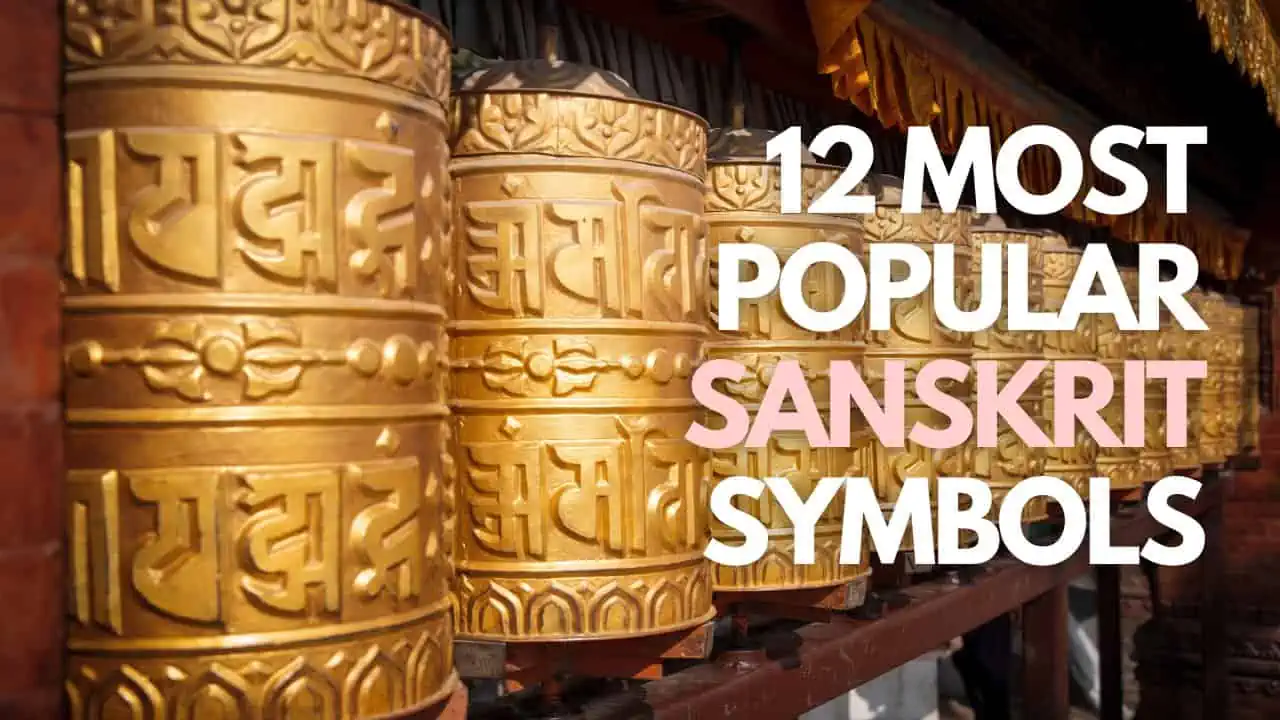





This is a great post! I’ve been learning about Sanskrit symbols and meanings, and this post has helped me understand some of them better. Thanks for sharing!